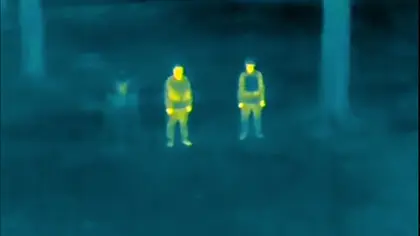The Ukrainian Ministry of Defense is developing an anti-thermal imaging poncho (cape) for the Ukrainian troops to help them blend into the background when viewed through night vision devices and infrared (IR) targeting systems, as reported on the ministry’s official website.
The project is under the purview of the Ministry’s Central Department of Development and Material Support.
JOIN US ON TELEGRAM
Follow our coverage of the war on the @Kyivpost_official.
“Our goal is to camouflage military personnel and equipment from the enemy as reliably as possible,” Deputy Defense Minister Vitaly Polovenko stated.
Five samples of various IR camouflage fabrics for the ponchos are presently being tested at the Central Department, focusing on creating a material that effectively absorbs infrared radiation and exhibits low thermal conductivity.
The Ministry says the developed product would render Ukrainian military personnel less visible to enemy thermal imagers and night vision devices.
The materials for the anti-thermal vision cape must be flexible, environmentally resistant to atmospheric conditions, sun-resistant (i.e., resistant to exposure to solar UV radiation), and possess effective masking properties in varied terrains, the statement discloses.
“Ongoing testing is currently in progress,” the message read.
Last October, Ukraine’s Deputy Prime Minister, Mykhailo Fedorov, announced the development of an invisibility cloak for the Ukrainian Armed Forces (AFU) troops, describing it as a “super defense” against Russian thermal imagers and drones equipped with thermal imaging cameras.

N. Korean Troops Massed in Russia to Enter Ukraine War ’Soon’: Pentagon Chief
While details on the functionality of the new clothing were not extensively revealed, Fedorov emphasized its compactness and lightweight design, weighing less than 2.5 kg. The poncho offers high protection against rain and wet snow, is non-flammable, and shields against high temperatures.
In a released video showcasing a finished sample, the effectiveness of the poncho was illustrated through thermal imaging footage of three figures – one presumably wearing the poncho and two not. The video didn’t indicate the conditions of the three and whether they had been motionless for some time.
As Kyiv Post analyst Steve Brown noted, the new anti-thermal imaging poncho results were not flawless. In Fedorov’s video, a dappled outline of the raincoat wearer was still visible.
Have u ever read about invisibility cloaks in fairy tales? Well, Ukrainians made it. The cloak blocks heat radiation & makes defenders invisible to Russian thermal cameras. It will help our soldiers work effectively during the night. Miltech magic supported by @Brave1ua cluster. pic.twitter.com/7OIE4Ciq2c
— Mykhailo Fedorov (@FedorovMykhailo) October 4, 2023
However, the poncho significantly reduces visibility compared to a standard uniform. This makes detection during an area scan considerably challenging, especially against the lower-quality or lower-resolution thermal imagers commonly found on Ukraine’s battlefield.
Last year, reports indicated Russian troop had attempted to mask their heat signatures with ponchos made from “mylar” metalized polyester or “space blankets.”
Ukrainian officer Tatarigami, in a post on X on April 24, 2023, noted that several captured or deceased Russian troops near Avdiivka, Donetsk, in Eastern Ukraine, were found with such blankets lining their uniforms.
🧵Thread
— Tatarigami_UA (@Tatarigami_UA) April 24, 2023
1/ Another noteworthy development in the ongoing invasion is the reported use of anti-thermal blankets/coats by russian soldiers in close proximity to Donetsk. pic.twitter.com/ho2NuX3l7Z
Recent mentions of a “fundamentally new” camouflage suit, reportedly developed by HiderX and capable of surpassing existing thermal camouflage, circulated in Russian state media at the end of January.
However, the specifics of this technology and its potential breakthroughs still need to be clarified.
HiderX claimed to have utilized “completely Russian technology” involving undisclosed chemical compounds layered onto fabric, resulting in a cloak that “blurs the silhouette” and weighs as little as 350 g, purportedly available by the end of January.
However, the same technology – using reflective material to block infrared (IR) emission and reduce thermal signature – has been available since at least 1964 by NASA in the form of a space blanket.
Today, these blankets are available for as little as $4 in outdoor shops and were used by the Taliban in Afghanistan during the 2000s to purportedly evade detection by US troops.
Nevertheless, the development of an anti-thermal imaging poncho by Ukraine represents a significant step in enhancing its armed forces' tactical capabilities and survivability in modern warfare scenarios.
You can also highlight the text and press Ctrl + Enter






